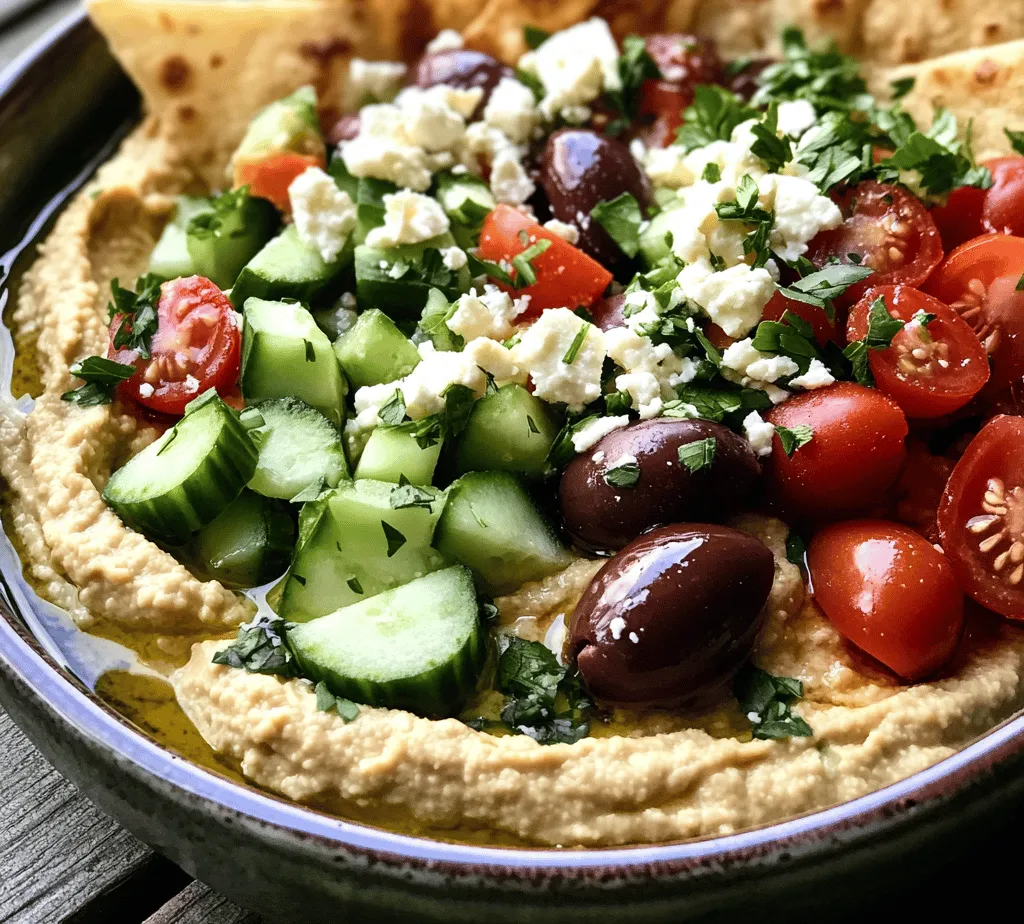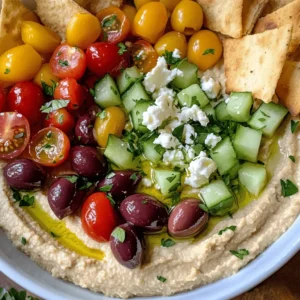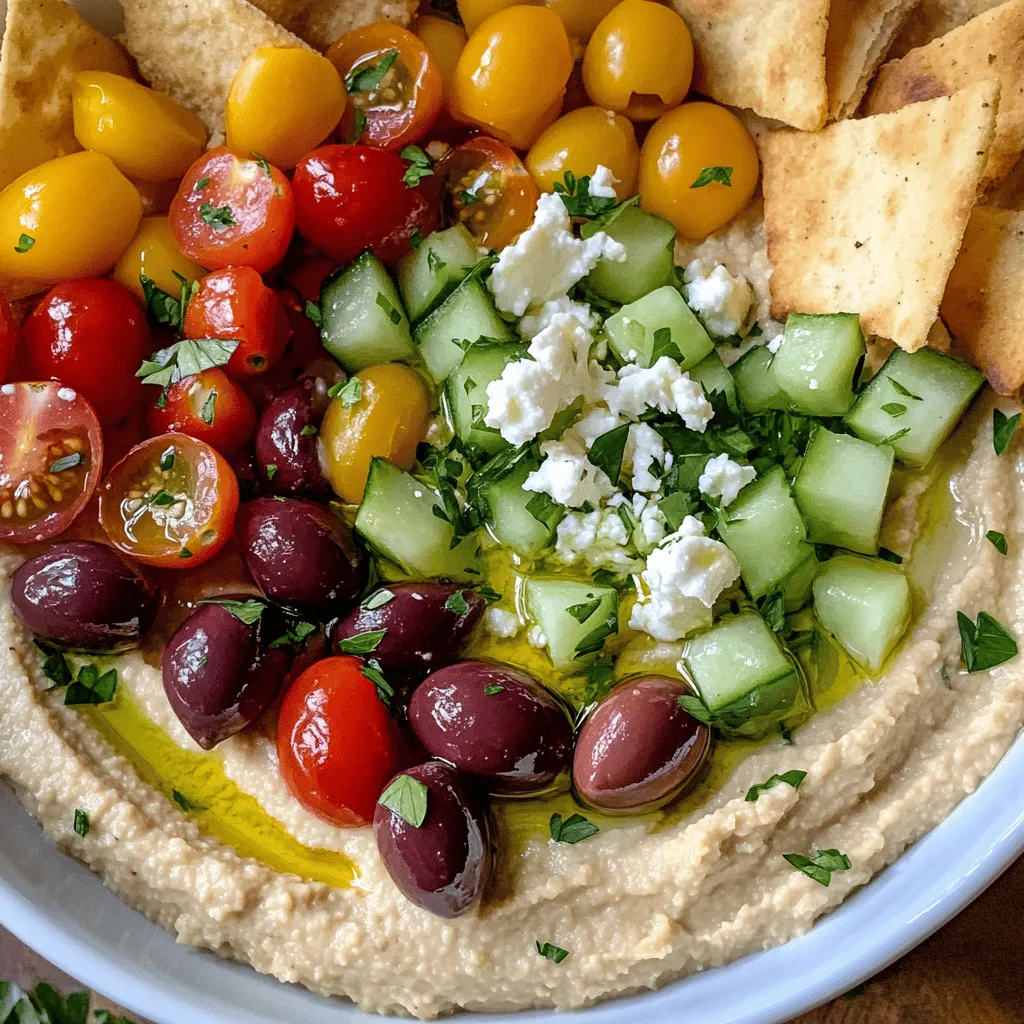Introduction
Mediterranean cuisine is renowned for its vibrant flavors, fresh ingredients, and health benefits, making it a favorite among food enthusiasts worldwide. One of its standout dishes is hummus, a creamy, versatile spread that serves as a staple across many cultures, especially in the Mediterranean and Middle Eastern regions. Hummus is not just a dip; it is a culinary canvas that can be adorned with various toppings, spices, and flavors, allowing it to shine in multiple contexts—from casual gatherings to elegant dinners.
In this article, we will explore a delightful twist on traditional hummus: Greek Style Loaded Hummus. This recipe elevates the classic chickpea spread with an array of fresh vegetables, savory feta cheese, and the richness of Greek yogurt, resulting in a dish that is not only visually stunning but also packed with flavor and nutrition. The simplicity of the recipe makes it an excellent choice for entertaining guests, serving as a satisfying snack, or enjoying as a healthy meal option. Whether you’re a hummus aficionado or a curious newcomer, this Greek style version promises to impress with its delightful taste and easy preparation.
Understanding Hummus: A Brief History
The origins of hummus are as rich and diverse as the flavors it embodies. While the exact birthplace of hummus is debated among historians, it is widely believed to have originated in the Levant region, which includes countries like Lebanon, Syria, and Palestine. The dish dates back centuries, with some historical texts suggesting that variations of hummus were consumed as early as the 13th century.
Hummus holds significant cultural importance, often serving as a symbol of hospitality and shared meals in many Middle Eastern and Mediterranean cultures. Traditionally made with simple ingredients—chickpeas, tahini, olive oil, lemon juice, and garlic—hummus has evolved over time, adapting to local tastes and ingredients while maintaining its core essence.
In recent years, hummus has gained immense popularity globally, particularly in health-conscious diets. With the rise of plant-based eating and an increased awareness of the benefits of legumes, hummus has found its way into the hearts (and kitchens) of people around the world. Its appeal lies not only in its delicious flavor but also in its nutritional profile, offering a hearty dose of protein, fiber, and healthy fats.
Ingredients Breakdown
Creating the perfect Greek Style Loaded Hummus requires selecting the freshest ingredients. Here’s a breakdown of each component, along with its nutritional benefits:
Chickpeas
Chickpeas, or garbanzo beans, serve as the foundation of hummus. They are a fantastic source of plant-based protein, making them an excellent choice for vegetarians and vegans. Packed with fiber, chickpeas support digestive health and help maintain stable blood sugar levels. Additionally, their low glycemic index makes them a great option for those looking to manage their weight.
Tahini
Tahini is a paste made from ground sesame seeds and is a traditional ingredient in hummus. It adds a creamy texture and a nutty flavor that complements the chickpeas beautifully. Nutritionally, tahini is rich in healthy fats, vitamins, and minerals, including calcium, which is essential for bone health. Its antioxidants also contribute to overall health and well-being.
Olive Oil
Olive oil is renowned for its heart-healthy properties, particularly its high content of monounsaturated fats. It not only enhances the flavor of hummus but also contributes to its smooth texture. Extra virgin olive oil, in particular, is loaded with antioxidants and anti-inflammatory compounds, making it a staple in Mediterranean diets known for promoting cardiovascular health.
Lemon Juice
Fresh lemon juice brings a bright, zesty acidity to hummus, balancing the richness of the tahini and olive oil. It also adds a boost of vitamin C, which supports the immune system and acts as an antioxidant. The acidity from lemon juice helps preserve the freshness of the hummus and enhances the overall flavor profile.
Garlic
Garlic is a key aromatic ingredient that elevates the flavor of hummus. Its distinctive taste adds depth, while its health benefits are well-documented. Garlic is known for its potential anti-inflammatory and immune-boosting properties, thanks to its high content of allicin—a compound that may help reduce blood pressure and improve cardiovascular health.
Cumin
Cumin is a warm spice that adds an earthy flavor to hummus. It has a distinctive aroma and taste that complements the other ingredients beautifully. Cumin is also known for its digestive benefits and may aid in improving gut health and metabolism.
Greek Yogurt
Incorporating Greek yogurt into the hummus adds an extra layer of creaminess and richness. Greek yogurt is higher in protein than regular yogurt, making it a nutritious addition that also contributes probiotics—beneficial bacteria that support gut health. Its tangy flavor enhances the overall taste of the dish, giving it a unique twist.
Fresh Vegetables
A variety of fresh vegetables are used as toppings for Greek Style Loaded Hummus, adding crunch, color, and nutritional value. Common choices include bell peppers, cucumbers, cherry tomatoes, and radishes. These vegetables not only enhance the presentation but also provide essential vitamins, minerals, and antioxidants.
Feta Cheese
Feta cheese is the crowning touch on this loaded hummus. Its salty tang complements the creamy hummus and adds a delicious Mediterranean flair. Feta is a source of protein and calcium, and it contributes to the overall flavor profile, making each bite delightfully savory.
Preparation Steps for Greek Style Loaded Hummus
Now that we have explored the ingredients and their benefits, let’s dive into the preparation process for Greek Style Loaded Hummus. This recipe is designed to be straightforward, allowing you to create a delicious and visually appealing dish in no time.
Blending the Base
1. Rinse and Drain the Chickpeas: Start by rinsing a can of chickpeas under cold water and draining them well. While using canned chickpeas is convenient, you can also opt for dried chickpeas that have been soaked overnight and cooked until tender for an even creamier texture.
2. Combine the Ingredients: In a high-speed blender or food processor, add the rinsed chickpeas, tahini, olive oil, lemon juice, minced garlic, and ground cumin. The ratios can be adjusted based on personal preference, but a general guideline is to use about 1 cup of chickpeas, ¼ cup of tahini, 2 tablespoons of olive oil, the juice of one lemon, one or two cloves of garlic, and 1 teaspoon of cumin.
3. Blend Until Smooth: Start blending the mixture on a low setting, gradually increasing the speed until the ingredients are well combined. Scrape down the sides of the bowl as needed to ensure everything is incorporated evenly. The goal is to achieve a smooth, creamy consistency. If the hummus is too thick, add a little water or extra olive oil, one tablespoon at a time, until the desired texture is reached.
4. Taste and Adjust: Once blended, taste the hummus and adjust the seasoning. You may want to add more lemon juice for acidity, salt for flavor, or additional garlic for a stronger punch. Blend again briefly to incorporate any adjustments.
5. Incorporate Greek Yogurt: For the Greek-style twist, gently fold in a half cup of Greek yogurt into the blended chickpea mixture, creating a rich and creamy texture that is characteristic of this variation. Be careful not to overmix, as you want to maintain the lightness of the hummus.
6. Prepare for Serving: Transfer the hummus to a serving bowl, making a small well in the center for the toppings. This is where you can get creative!
This Greek Style Loaded Hummus is not only a feast for the eyes but also a celebration of the Mediterranean flavors that make this region’s cuisine so beloved. In the following sections, we will explore how to top your hummus with fresh vegetables, feta cheese, and a drizzle of olive oil to create an irresistible dish that will be the star of any gathering.
Stay tuned as we delve deeper into the art of presenting and enjoying this delicious recipe, ensuring you master the elements that make Greek Style Loaded Hummus a standout choice in your culinary repertoire.

Creating the Topping
To elevate your Greek Style Loaded Hummus, the topping is where you can truly showcase freshness and flavor. Start by preparing your vegetables. A combination of cherry tomatoes, cucumbers, red onions, and bell peppers works beautifully. Dice the tomatoes and cucumbers into small, even pieces for a uniform look. Thinly slice the red onions and bell peppers to maintain their crunch while ensuring they integrate seamlessly with the other ingredients.
Next, place the chopped vegetables into a mixing bowl. Add crumbled feta cheese, which brings a creamy texture and salty bite that complements the freshness of the veggies. To enhance the flavors, drizzle in a tablespoon of high-quality extra virgin olive oil and a splash of red wine vinegar. This not only adds depth but also brightens the dish. Season the mixture with salt and freshly cracked black pepper to taste. For an extra layer of flavor, consider adding a pinch of dried oregano, which is a staple in Greek cuisine.
Toss all the ingredients gently until they are well combined. Allow the mixture to sit for about 10-15 minutes at room temperature. This resting time lets the flavors meld together, enhancing the overall taste of your topping. If you prefer a bit more acidity, squeeze in some fresh lemon juice right before serving to give it that zesty lift.
Assembly
When it comes to assembly, presentation is key for making your Greek Style Loaded Hummus visually appealing. Start by spreading a generous layer of your creamy homemade hummus onto a large serving platter or shallow bowl. Use the back of a spoon to create a slight well in the center of the hummus, which will serve as a perfect base for your toppings.
Carefully spoon the prepared vegetable and feta topping into the well you’ve created. Spread it evenly, allowing some of the topping to cascade over the edges for an enticing effect. The vibrant colors of the veggies against the smooth, pale hummus create an eye-catching contrast that will draw guests to the dish.
Drizzle additional olive oil over the top of the loaded hummus for added richness and shine. To finish, sprinkle a few more crumbles of feta, a dash of paprika or sumac for a pop of color, and fresh herbs like parsley or dill for that final touch. This careful layering not only looks beautiful but also invites diners to dig in and enjoy the harmonious blend of flavors.
Serving Suggestions
Greek Style Loaded Hummus is incredibly versatile and can be served in various delightful ways. Here are some serving suggestions that will make your dish a standout at any gathering:
– Pita Chips: Pita chips are the classic accompaniment for hummus. Their crunchy texture provides a satisfying contrast to the creamy hummus. You can easily make your own by cutting pita bread into triangles, brushing them with olive oil, sprinkling with salt, and baking until crispy. Alternatively, store-bought options are equally delicious.
– Fresh Veggies: Create a colorful platter of fresh, raw vegetables to serve alongside the hummus. Carrot sticks, celery, bell pepper slices, and cucumber rounds are not only healthy but also add a refreshing crunch. This option appeals to health-conscious guests and adds a rainbow of color to your spread.
– Creative Serving Ideas: Think beyond the traditional dip. Use Greek Style Loaded Hummus as a spread on sandwiches or wraps, making for a flavorful alternative to mayonnaise. It can also serve as a star attraction at a mezze platter, surrounded by olives, dolmas, and grilled vegetables, creating a feast for the senses that encourages sharing and communal dining.
The Health Benefits of Greek Style Loaded Hummus
Greek Style Loaded Hummus is not only delicious but also packed with nutritional benefits. This dish is a powerhouse of macronutrients and micronutrients, making it a smart choice for those looking to maintain a balanced diet.
– Fiber-Rich Ingredients: The base of hummus is chickpeas, which are an excellent source of dietary fiber. This fiber aids in digestion, promotes satiety, and can help maintain a healthy weight. Pairing the hummus with fresh vegetables further enhances the fiber content, contributing to overall digestive health.
– Healthy Fats: The addition of olive oil and tahini (sesame paste) provides heart-healthy fats that are essential for a balanced diet. These fats help reduce bad cholesterol levels and support cardiovascular health. Olive oil is also rich in antioxidants, which can combat inflammation and support overall wellness.
– Vitamins and Minerals: The fresh vegetables used as toppings are loaded with vitamins and minerals, including vitamin C, potassium, and antioxidants. These nutrients play a vital role in maintaining a healthy immune system, regulating blood pressure, and promoting overall health.
Customization and Variations
One of the wonderful aspects of Greek Style Loaded Hummus is its flexibility and the opportunity for customization. Here are a few ideas to encourage creativity in your kitchen:
– Modify Toppings: Feel free to adjust the toppings based on what’s in season or what you have on hand. Grilled zucchini, roasted red peppers, or even artichoke hearts can provide a unique twist. If you’re a fan of olives, adding a variety of kalamata or green olives can enhance the Mediterranean flair.
– Adjust the Spice Level: For those who enjoy a bit of heat, consider adding diced jalapeños or a sprinkle of red pepper flakes to the topping. This can add a nice kick that complements the creamy hummus.
– Explore Different Flavor Profiles: Incorporating fresh herbs like dill, mint, or parsley can transform the dish and offer new flavor dimensions. Each herb brings its own unique taste that can elevate the overall experience. For instance, mint adds a refreshing note, while dill brings a classic Greek flavor.
Cultural Significance of Hummus in Greek Cuisine
Hummus holds a special place in Greek dining traditions, often enjoyed as part of a larger mezze platter. Mezze refers to a variety of small dishes served as appetizers, encouraging sharing and communal dining. This style of eating aligns with the Greek philosophy of hospitality, where food brings people together.
In Greek culture, meals are often seen as an opportunity to connect with family and friends. Dishes like hummus, served alongside olives, bread, and other small plates, create a vibrant dining experience that emphasizes togetherness. The communal aspect of sharing food is deeply rooted in Greek tradition, making Greek Style Loaded Hummus not just a dish, but an experience to be savored.
Conclusion
Greek Style Loaded Hummus stands out as a refreshing, nutritious, and visually stunning dish that is perfect for any occasion. Its simple preparation makes it accessible for home cooks of all skill levels, while its vibrant presentation is sure to impress guests. By incorporating fresh ingredients and healthy fats, this dish not only satisfies the palate but also provides numerous health benefits.
Bringing a piece of Mediterranean culture into your kitchen has never been easier or more rewarding. Whether served as a dip, spread, or part of a larger feast, Greek Style Loaded Hummus invites everyone to enjoy the rich flavors and communal spirit that define Greek dining. So gather your ingredients, unleash your creativity, and dive into this delightful dish that is sure to become a staple in your recipe repertoire.


